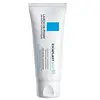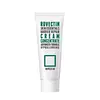What's inside
What's inside
 Key Ingredients
Key Ingredients

 Benefits
Benefits

 Concerns
Concerns

 Ingredients Side-by-side
Ingredients Side-by-side

Water
Skin ConditioningHydrogenated Polyisobutene
EmollientDimethicone 1%
EmollientGlycerin
HumectantButyrospermum Parkii Butter
Skin ConditioningPanthenol
Skin ConditioningAluminum Starch Octenylsuccinate
AbsorbentButylene Glycol
HumectantPropanediol
SolventCetyl PEG/PPG-10/1 Dimethicone
EmulsifyingTrihydroxystearin
Skin ConditioningZinc Gluconate
Skin ConditioningMadecassoside
AntioxidantManganese Gluconate
Skin ConditioningSilica
AbrasiveAluminum Hydroxide
EmollientMagnesium Sulfate
Disodium EDTA
Copper Gluconate
Skin ConditioningCitric Acid
BufferingAcetylated Glycol Stearate
EmollientPolyglyceryl-4 Isostearate
EmulsifyingTocopherol
AntioxidantPentaerythrityl Tetra-Di-T-Butyl Hydroxyhydrocinnamate
AntioxidantSodium Benzoate
MaskingPhenoxyethanol
PreservativeChlorhexidine Digluconate
AntimicrobialTitanium Dioxide
Cosmetic ColorantWater, Hydrogenated Polyisobutene, Dimethicone 1%, Glycerin, Butyrospermum Parkii Butter, Panthenol, Aluminum Starch Octenylsuccinate, Butylene Glycol, Propanediol, Cetyl PEG/PPG-10/1 Dimethicone, Trihydroxystearin, Zinc Gluconate, Madecassoside, Manganese Gluconate, Silica, Aluminum Hydroxide, Magnesium Sulfate, Disodium EDTA, Copper Gluconate, Citric Acid, Acetylated Glycol Stearate, Polyglyceryl-4 Isostearate, Tocopherol, Pentaerythrityl Tetra-Di-T-Butyl Hydroxyhydrocinnamate, Sodium Benzoate, Phenoxyethanol, Chlorhexidine Digluconate, Titanium Dioxide
Water
Skin ConditioningPropanediol
SolventCetyl Ethylhexanoate
EmollientButylene Glycol
HumectantHydrogenated Poly(C6-14 Olefin)
EmollientSqualane
EmollientTheobroma Cacao Seed Butter
EmollientCetearyl Alcohol
EmollientPolyglyceryl-3 Methylglucose Distearate
EmulsifyingCaprylic/Capric Triglyceride
MaskingNiacinamide
SmoothingPentylene Glycol
Skin ConditioningGlyceryl Stearate
EmollientHydrogenated Vegetable Oil
EmollientPrunus Persica Kernel Oil
EmollientCeramide NP
Skin ConditioningAstaxanthin
Skin ConditioningPanthenol
Skin ConditioningRubus Idaeus Seed Oil
EmollientRosa Damascena Flower Oil
MaskingOlea Europaea Fruit Oil
MaskingHaematococcus Pluvialis Extract
AntioxidantEclipta Prostrata Extract
Skin ConditioningMelia Azadirachta Flower Extract
Skin ConditioningPelargonium Graveolens Flower Oil
MaskingMelia Azadirachta Leaf Extract
Skin ConditioningCitrus Aurantium Dulcis Peel Oil
MaskingCurcuma Longa Root Extract
MaskingOcimum Sanctum Leaf Extract
Skin ConditioningEucalyptus Globulus Leaf Oil
PerfumingJuniperus Mexicana Oil
MaskingSalvia Sclarea Oil
MaskingCorallina Officinalis Extract
Skin ConditioningMoringa Oleifera Seed Oil
Emollient1,2-Hexanediol
Skin ConditioningDiisostearyl Malate
EmollientPolymethylsilsesquioxane
Synthetic Beeswax
Emulsion StabilisingCetearyl Olivate
Sorbitan Olivate
EmulsifyingHydroxyethyl Acrylate/Sodium Acryloyldimethyl Taurate Copolymer
Emulsion StabilisingHydroxyacetophenone
AntioxidantPalmitic Acid
EmollientStearic Acid
CleansingSodium Polyacryloyldimethyl Taurate
Emulsion StabilisingHydrogenated Polydecene
EmollientTromethamine
BufferingAdenosine
Skin ConditioningSorbitan Isostearate
EmulsifyingSodium Phytate
Trideceth-10
CleansingCarbomer
Emulsion StabilisingXanthan Gum
EmulsifyingHydrogenated Lecithin
EmulsifyingGlycerin
HumectantWater, Propanediol, Cetyl Ethylhexanoate, Butylene Glycol, Hydrogenated Poly(C6-14 Olefin), Squalane, Theobroma Cacao Seed Butter, Cetearyl Alcohol, Polyglyceryl-3 Methylglucose Distearate, Caprylic/Capric Triglyceride, Niacinamide, Pentylene Glycol, Glyceryl Stearate, Hydrogenated Vegetable Oil, Prunus Persica Kernel Oil, Ceramide NP, Astaxanthin, Panthenol, Rubus Idaeus Seed Oil, Rosa Damascena Flower Oil, Olea Europaea Fruit Oil, Haematococcus Pluvialis Extract, Eclipta Prostrata Extract, Melia Azadirachta Flower Extract, Pelargonium Graveolens Flower Oil, Melia Azadirachta Leaf Extract, Citrus Aurantium Dulcis Peel Oil, Curcuma Longa Root Extract, Ocimum Sanctum Leaf Extract, Eucalyptus Globulus Leaf Oil, Juniperus Mexicana Oil, Salvia Sclarea Oil, Corallina Officinalis Extract, Moringa Oleifera Seed Oil, 1,2-Hexanediol, Diisostearyl Malate, Polymethylsilsesquioxane, Synthetic Beeswax, Cetearyl Olivate, Sorbitan Olivate, Hydroxyethyl Acrylate/Sodium Acryloyldimethyl Taurate Copolymer, Hydroxyacetophenone, Palmitic Acid, Stearic Acid, Sodium Polyacryloyldimethyl Taurate, Hydrogenated Polydecene, Tromethamine, Adenosine, Sorbitan Isostearate, Sodium Phytate, Trideceth-10, Carbomer, Xanthan Gum, Hydrogenated Lecithin, Glycerin
 Reviews
Reviews

Alternatives
Ingredients Explained
These ingredients are found in both products.
Ingredients higher up in an ingredient list are typically present in a larger amount.
Butylene Glycol (or BG) is used within cosmetic products for a few different reasons:
Overall, Butylene Glycol is a safe and well-rounded ingredient that works well with other ingredients.
Though this ingredient works well with most skin types, some people with sensitive skin may experience a reaction such as allergic rashes, closed comedones, or itchiness.
Learn more about Butylene GlycolGlycerin is already naturally found in your skin. It helps moisturize and protect your skin.
A study from 2016 found glycerin to be more effective as a humectant than AHAs and hyaluronic acid.
As a humectant, it helps the skin stay hydrated by pulling moisture to your skin. The low molecular weight of glycerin allows it to pull moisture into the deeper layers of your skin.
Hydrated skin improves your skin barrier; Your skin barrier helps protect against irritants and bacteria.
Glycerin has also been found to have antimicrobial and antiviral properties. Due to these properties, glycerin is often used in wound and burn treatments.
In cosmetics, glycerin is usually derived from plants such as soybean or palm. However, it can also be sourced from animals, such as tallow or animal fat.
This ingredient is organic, colorless, odorless, and non-toxic.
Glycerin is the name for this ingredient in American English. British English uses Glycerol/Glycerine.
Learn more about GlycerinPanthenol is a common ingredient that helps hydrate and soothe the skin. It is found naturally in our skin and hair.
There are two forms of panthenol: D and L.
D-panthenol is also known as dexpanthenol. Most cosmetics use dexpanthenol or a mixture of D and L-panthenol.
Panthenol is famous due to its ability to go deeper into the skin's layers. Using this ingredient has numerous pros (and no cons):
Like hyaluronic acid, panthenol is a humectant. Humectants are able to bind and hold large amounts of water to keep skin hydrated.
This ingredient works well for wound healing. It works by increasing tissue in the wound and helps close open wounds.
Once oxidized, panthenol converts to pantothenic acid. Panthothenic acid is found in all living cells.
This ingredient is also referred to as pro-vitamin B5.
Learn more about PanthenolPropanediol is an all-star ingredient. It softens, hydrates, and smooths the skin.
It’s often used to:
Propanediol is not likely to cause sensitivity and considered safe to use. It is derived from corn or petroleum with a clear color and no scent.
Learn more about PropanediolWater. It's the most common cosmetic ingredient of all. You'll usually see it at the top of ingredient lists, meaning that it makes up the largest part of the product.
So why is it so popular? Water most often acts as a solvent - this means that it helps dissolve other ingredients into the formulation.
You'll also recognize water as that liquid we all need to stay alive. If you see this, drink a glass of water. Stay hydrated!
Learn more about Water